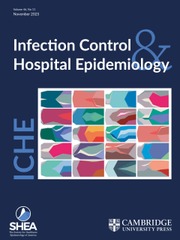Crossref Citations
This article has been cited by the following publications. This list is generated based on data provided by
Crossref.
Boyce, John M.
1992.
Methicillin-Resistant Staphylococcus aureus in Hospitals and Long-Term Care Facilities: Microbiology, Epidemiology, and Preventive Measures.
Infection Control and Hospital Epidemiology,
Vol. 13,
Issue. 12,
p.
725.
Venezia, Richard A.
Harris, Valerie
Miller, Cynthia
Peck, Hilary
and
Antonio, Mara San
1992.
Investigation of an Outbreak of Methicillin-Resistant Staphylococcus aureus in Patients With Skin Disease Using DNA Restriction Patterns.
Infection Control & Hospital Epidemiology,
Vol. 13,
Issue. 8,
p.
472.
Trilla, Antoni
Nettleman, Mary D.
Hollis, Richard J.
Fredrickson, Mary
Wenzel, Richard P.
and
Pfaller, Michael A.
1993.
Restriction Endonuclease Analysis of Plasmid DNA From Methicillin-Resistant Staphylococcus aureus: Clinical Application Over a Three-Year Period.
Infection Control & Hospital Epidemiology,
Vol. 14,
Issue. 1,
p.
29.
Branchini, Maria Luiza M.
Morthland, Virginia H.
Tresoldi, Antonia T.
Von Nowakonsky, Angela
Dias, Maria Beatriz Souza
and
Pfaller, Michael A.
1993.
Application of genomic DNA subtyping by pulsed field gel electrophoresis and restriction enzyme analysis of plasmid DNA to characterize methicillin-resistant Staphylococcus aureus from two nosocomial outbreaks.
Diagnostic Microbiology and Infectious Disease,
Vol. 17,
Issue. 4,
p.
275.
Poh, C.L.
Yap, S.C.
and
Yeo, M.
1993.
Pulsed-field gel electrophoresis for differentiation of hospital isolates of Klebsiella pneumoniae.
Journal of Hospital Infection,
Vol. 24,
Issue. 2,
p.
123.
Vickery, A.M.
1993.
Strains of methicillin-resistant Staphylococcus aureus isolated in Australian hospitals from 1986 to 1990.
Journal of Hospital Infection,
Vol. 24,
Issue. 2,
p.
139.
Mulligan, Maury Ellis
Murray-Leisure, Katherine A.
Ribner, Bruce S.
Standiford, Harold C.
John, Joseph F.
Korvick, Joyce A.
Kauffman, Carol A.
and
Yu, Victor L.
1993.
Methicillin-resistant Staphylococcus aureus: A consensus review of the microbiology, pathogenesis, and epidemiology with implications for prevention and management.
The American Journal of Medicine,
Vol. 94,
Issue. 3,
p.
313.
Kreiswirth, Barry
Kornblum, John
Arbeit, Robert D.
Eisner, William
Maslow, Joel N.
McGeer, Allison
Low, Donald E.
and
Novick, Richard P.
1993.
Evidence for a Clonal Origin of Methicillin Resistance in
Staphylococcus aureus
.
Science,
Vol. 259,
Issue. 5092,
p.
227.
Sader, Helio S.
Pignatari, Antonio C.
Hollis, Richard J.
and
Jones, Ronald N.
1994.
Evaluation of Interhospital Spread of Methicillin-Resistant Staphylococcus aureus in Sao Paulo, Brazil, Using Pulsed-Field Gel Electrophoresis of Chromosomal DNA.
Infection Control & Hospital Epidemiology,
Vol. 15,
Issue. 5,
p.
320.
Sabria-Leal, Miquel
Morthland, Virginia H.
Pedro-Botet, Maria L.
Sopena, Nieves
Gimenez-Perez, Monserrat
Branchini, Maria L. M.
and
Pfaller, Michael A.
1994.
Molecular epidemiology for local outbreaks of methicillin resistantStaphylococcus aureus (MRSA).
European Journal of Epidemiology,
Vol. 10,
Issue. 3,
p.
325.
Boyce, John M.
Jackson, Marguerite M.
Pugliese, Gina
Batt, Murray D.
Fleming, David
Garner, Julia S.
Hartstein, Alan I.
Kauffman, Carol A.
Simmons, Mildred
Weinstein, Robert
and
Williams, Carol O'Boyle
1994.
Methicillin-Resistant Staphylococcus aureus (MRSA): A Briefing for Acute Care Hospitals and Nursing Facilities.
Infection Control & Hospital Epidemiology,
Vol. 15,
Issue. 2,
p.
105.
Schumacher-Perdreau, F.
Jansen, B.
Seifert, H.
Peters, G.
and
Pulverer, G.
1994.
Outbreak of methicillin-resistant Staphylococcus aureus in a Teaching Hospital — epidemiological and microbiological surveillance.
Zentralblatt für Bakteriologie,
Vol. 280,
Issue. 4,
p.
550.
Talon, D.
Rouget, C.
Cailleaux, V.
Bailly, P.
Thouverez, M.
Barale, F.
and
Michel-Briand, Y.
1995.
Nasal carriage of Staphylococcus aureus and cross-contamination in a surgical intensive care unit: efficacy of mupirocin ointment.
Journal of Hospital Infection,
Vol. 30,
Issue. 1,
p.
39.
Layton, Marcelle C.
Hierholzer, Walter J.
and
Patterson, Jan Evans
1995.
The Evolving Epidemiology of Methicillin-Resistant Staphylococcus aureus at a University Hospital.
Infection Control & Hospital Epidemiology,
Vol. 16,
Issue. 1,
p.
12.
Lugeon, Catherine
Blanc, Dominique S.
Wenger, Aline
and
Francioli, Patrick
1995.
Molecular Epidemiology of Methicillin-Resistant Staphyloccocus aureus at a Low-Incidence Hospital over a 4-Year Period.
Infection Control & Hospital Epidemiology,
Vol. 16,
Issue. 5,
p.
260.
Hartstein, Alan I.
1995.
Improved Understanding and Control of Nosocomial Methicillin-Resistant Staphylococcus aureus: Are We Overdoing It?.
Infection Control & Hospital Epidemiology,
Vol. 16,
Issue. 5,
p.
257.
Wildemauwe, C.
Godard, C.
Vanhoof, R.
Van Bossuyt, E.
and
Hannecart-Pokorni, E.
1996.
Changes in major populations of methicillin-resistant Staphylococcus aureus in Belgium.
Journal of Hospital Infection,
Vol. 34,
Issue. 3,
p.
197.
Talon, D.
Cailleaux, V.
Thouverez, M.
and
Michel-Briand, Y.
1996.
Discriminatory power and usefulness of pulsed-field gel electrophoresis in epidemiological studies of Pseudomonas aeruginosa.
Journal of Hospital Infection,
Vol. 32,
Issue. 2,
p.
135.
Nada, T.
Ichiyama, S.
Osada, Y.
Ohta, M.
Shimokata, K.
Kato, N.
and
Nakashima, N.
1996.
Comparison of DNA fingerprinting by PFGE and PCR-RFLP of the coagulase gene to distinguish MRSA isolates.
Journal of Hospital Infection,
Vol. 32,
Issue. 4,
p.
305.
Hartstein, Alan I.
LeMonte, Ann M.
and
Iwamoto, Pamela K.L.
1997.
DNA Typing and Control of Methicillin-Resistant Staphylococcus aureus at Two Affiliated Hospitals.
Infection Control & Hospital Epidemiology,
Vol. 18,
Issue. 1,
p.
42.

